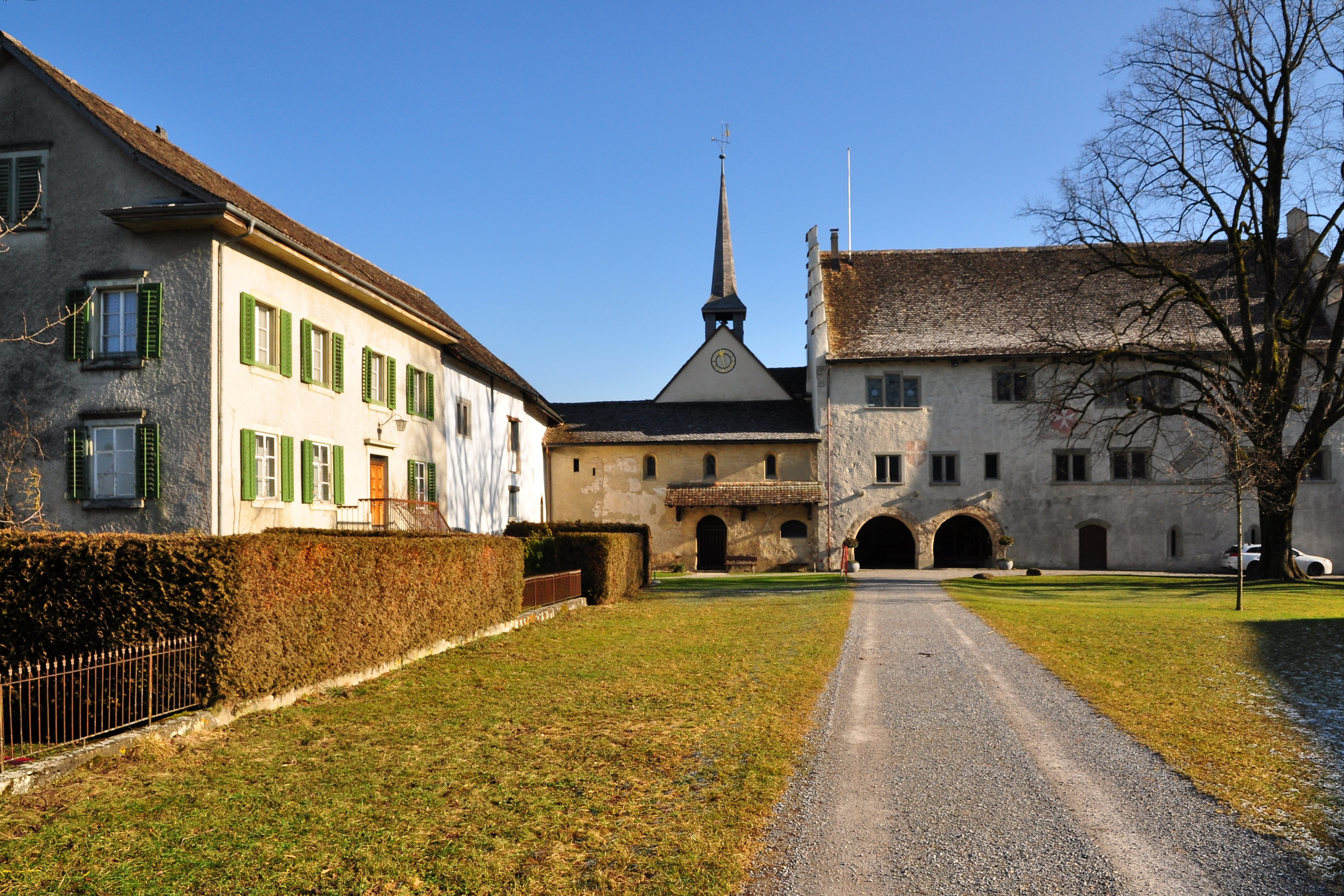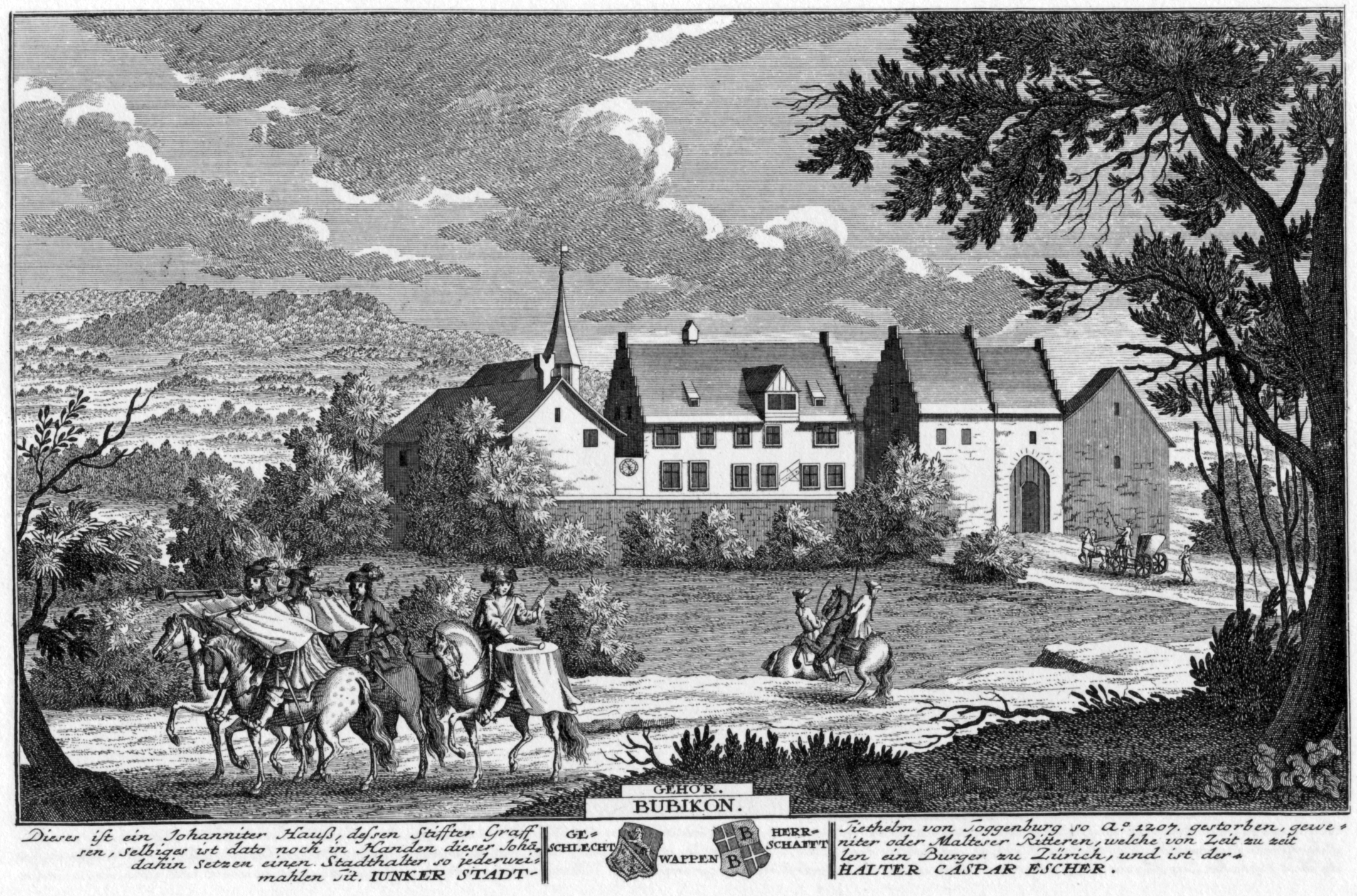Bubikon Commandry on:
[Wikipedia]
[Google]
[Amazon]
Bubikon Castle or Bubikon Commandery () is a 
 The commandry's inhabitants was granted
The commandry's inhabitants was granted
File:Bubikon_-_Ritterhaus_IMG_6399.JPG
File:Bubikon - Ritterhaus 2010-11-11 14-06-48 ShiftN.jpg
File:Bubikon - Ritterhaus IMG 6411.JPG
File:Bubikon - Ritterhaus - Dürnten - Bubikon Büelhölzli 2010-11-11 14-37-26.jpg

 The ''Ritterhaus'' building complex consists of the commander's house, the rectory, the ''Schütte'' and ''Sennhaus'' buildings, the so-called ''Bruderhaus'' being the oldest building, the 12th-century chapel of St.
The ''Ritterhaus'' building complex consists of the commander's house, the rectory, the ''Schütte'' and ''Sennhaus'' buildings, the so-called ''Bruderhaus'' being the oldest building, the 12th-century chapel of St.
Bubikon - Ritterhaus - Kräutergarten 2011-09-28 11-34-04 ShiftN.jpg, herb garden on the southern side of the ''Gesindehaus'' building
Bubikon - Ritterhaus 2011-09-28 11-25-42 ShiftN.jpg, chapel and adjacent main building
Bubikon - Ritterhaus IMG 6458.JPG, coats of arms of the order
Bubikon - Ritterhaus 2010-11-11 14-16-26 ShiftN.jpg, ''Gesindehaus''
The commander's building houses the ''Ritterhaus'' history museum that was established in the 1940s. Its ''Hotz coin collection'' shows an assortment of more than 400 coins that give record of the Order and its Grandmasters from 14th to 18th century. The museum also comprises the collection of antique arms of Johann Jakob Vogel (1813–1862) who donated about 220 arms to the Ritterhaus Bubikon. In 2011 the so-called ''Epochen-Kräutergarten'' ("epochal herb garden") opened to the public presenting medieval herbs from the ''ancient world'' on about .
{{DEFAULTSORT:Bubikon Castle Cultural property of national significance in the canton of Zurich Castles in the canton of Zürich House of Rapperswil Christian monasteries established in the 1190s Preceptories of the Knights Hospitaller in Switzerland 1528 disestablishments in Europe 16th-century disestablishments in the Old Swiss Confederacy Museums in the canton of Zürich History museums in Switzerland Bubikon
castle
A castle is a type of fortification, fortified structure built during the Middle Ages predominantly by the nobility or royalty and by Military order (monastic society), military orders. Scholars usually consider a ''castle'' to be the private ...
in the municipality
A municipality is usually a single administrative division having municipal corporation, corporate status and powers of self-government or jurisdiction as granted by national and regional laws to which it is subordinate.
The term ''municipality' ...
of Bubikon
Bubikon is a Municipalities of Switzerland, municipality in the district of Hinwil (district), Hinwil in the Cantons of Switzerland, canton of Zurich (canton), Zürich in Switzerland.
History
Some names of localities have Celts, Celtic (''M� ...
of the Swiss Canton of Zürich
The canton of Zurich is an administrative unit (Swiss canton, canton) of Switzerland, situated in the northeastern part of the country. With a population of (as of ), it is the most populous canton of Switzerland. Zurich is the ''de facto'' Capi ...
. The former Commandery
In the Middle Ages, a commandery (rarely commandry) was the smallest administrative division of the European landed properties of a military order. It was also the name of the house where the knights of the commandery lived.Anthony Luttrell and G ...
, a medieval monastery of the Knights Hospitaller
The Order of Knights of the Hospital of Saint John of Jerusalem, commonly known as the Knights Hospitaller (), is a Catholic military order. It was founded in the crusader Kingdom of Jerusalem in the 12th century and had headquarters there ...
, is a Swiss heritage site of national significance.

History
Assumably in compensation of claims related to the ''Alt-Rapperswil
The House of Rapperswil respectively Counts of Rapperswil (''Grafen von Rapperwil'' since 1233, before ''Lords'') ruled the Obersee (Zürichsee), upper ''Zürichsee'' and ''Seedamm'' region around Rapperswil and parts of, as of today, Canton (S ...
'' lands and rights, a change of goods occurred between the Counts of Toggenburg
The counts of Toggenburg (''Grafen von Toggenburg'') ruled the Toggenburg region of today's canton of St. Gallen, Switzerland, and adjacent areas during the 13th to 15th centuries.
A baronial family of Toggenburg is mentioned in the 11th and 1 ...
and Counts of Rapperswil
The House of Rapperswil respectively Counts of Rapperswil (''Grafen von Rapperwil'' since 1233, before ''Lords'') ruled the upper ''Zürichsee'' and ''Seedamm'' region around Rapperswil and parts of, as of today, Swiss cantons of St. Gallen, ...
probably in the early 1190s. To end the disputes about the legacy, the Knights Hospitaller
The Order of Knights of the Hospital of Saint John of Jerusalem, commonly known as the Knights Hospitaller (), is a Catholic military order. It was founded in the crusader Kingdom of Jerusalem in the 12th century and had headquarters there ...
abbey and commandry
In the Middle Ages, a commandery (rarely commandry) was the smallest administrative division of the European landed properties of a military order. It was also the name of the house where the knights of the commandery lived.Anthony Luttrell and G ...
was given by Diethelm V von Toggenburg and Vogt Rudolf von Rapperswil between 1191 and 1198 AD. Although in concurrency to the neighbouring Rüti Abbey Rüti, which comes from the Old High German word , meaning " clearing", is a popular name for towns in the German speaking part of Switzerland. It can refer to the following:
* Rüti, Glarus in Glarus
*Rüti, Zürich in Zürich
*: Rüti Reformed C ...
, the commandery's lands and goods grew with donations by local noble families during the 13th and 14th centuries – at the height of their power, the commandry owned land all over the present canton of Zürich.
 The commandry's inhabitants was granted
The commandry's inhabitants was granted Burgrecht
A Burgrecht (''ius burgense, ius civile'') was a medieval agreement, most commonly in southern Germany and northern German-speaking Switzerland. It came to refer to an agreement between a town and surrounding settlements or to include the specific ...
by the neighbouring town of Rapperswil
Rapperswil (Swiss German: or ;Andres Kristol, ''Rapperswil SG (See)'' in: ''Dictionnaire toponymique des communes suisses – Lexikon der schweizerischen Gemeindenamen – Dizionario toponomastico dei comuni svizzeri (DTS, LSG)'', Centre de dial ...
, later by the city of Zürich. During the Reformation in Zürich
The Reformation in Zürich was promoted initially by Huldrych Zwingli, who gained the support of the magistrates of the city of Zürich and the princess abbess Katharina von Zimmern of the Fraumünster Abbey, and the population of the city of Hist ...
and the riots in the Herrschaft Grüningen against the feudal owners of the lands cultivated by the farmers and their families, Johannes Stumpf, the prior of the commandry at the time, supported its secularization and those of the neighbouring Rüti Abbey Rüti, which comes from the Old High German word , meaning " clearing", is a popular name for towns in the German speaking part of Switzerland. It can refer to the following:
* Rüti, Glarus in Glarus
*Rüti, Zürich in Zürich
*: Rüti Reformed C ...
in spring 1525. The lands partially became the property of the city of Zürich
Zurich (; ) is the largest city in Switzerland and the capital of the canton of Zurich. It is in north-central Switzerland, at the northwestern tip of Lake Zurich. , the municipality had 448,664 inhabitants. The urban area was home to 1.45 mi ...
when the convent was secularized in 1528 (convent) respectively 1798 (commandry).
Buildings
In 1936 respectively 1938 the ''Ritterhausgesellschaft'' (Ritterhaus society) took over the management of the building complex, and the society today provides the museum related to the castle's and the order's history. The buildings of the commandry were completely renewed in 1947, and the chapel between 1993 and 1995. In 2000 the museum was redesigned, and a herbal garden (German: ''Epochen-Kräutergarten'') was established and the exterior partially renewed in 2011. The adjacent farm and barn buildings are excluded from the ''Ritterhaus'' building complex, as they still are used as a privately cultivated farm.
 The ''Ritterhaus'' building complex consists of the commander's house, the rectory, the ''Schütte'' and ''Sennhaus'' buildings, the so-called ''Bruderhaus'' being the oldest building, the 12th-century chapel of St.
The ''Ritterhaus'' building complex consists of the commander's house, the rectory, the ''Schütte'' and ''Sennhaus'' buildings, the so-called ''Bruderhaus'' being the oldest building, the 12th-century chapel of St. John the Baptist
John the Baptist ( – ) was a Jewish preacher active in the area of the Jordan River in the early first century AD. He is also known as Saint John the Forerunner in Eastern Orthodoxy and Oriental Orthodoxy, John the Immerser in some Baptist ...
(dated 1192 AD), as well as the adjacent farm and economic buildings. The brothers’ house (''Bruderhaus'') and the chapel are the oldest buildings of the commandery and were probably built in the early 1190s, assumably incorporating an older building (maybe a chapel) that was built by the Toggenburg family. The 14th-century Romanesque nave of the chapel was expanded by a Gothic chancel that was destroyed in 1819. The remains of Romanesque mural paintings date back to the first half of the 13th century. They illustrate the foundation of the commonly named ''Ritterhaus'' building complex by the Toggenburg and Rapperswil families, and display scenes of the live of Saint John the Baptist. The chapel was desecrated and secularised during the Reformation in Zürich
The Reformation in Zürich was promoted initially by Huldrych Zwingli, who gained the support of the magistrates of the city of Zürich and the princess abbess Katharina von Zimmern of the Fraumünster Abbey, and the population of the city of Hist ...
. The main building (''Haupthaus''), serving as the commander's house and administration complex, and the adjacent wing (''Ritterhausflügel'') were added between the 13th and 15th century; after the Reformation it was the seat of the local governor, a city council member from Zürich. The representative rooms were used for official purposes, and therefore richly decorated in the Renaissance style in 1570. At the same time, the coats of arms of the Knights of Malta was painted onto the façade towards the courtyard. The servants' house (''Sennhaus'', ''Gesindehaus'') was built around 1480 and rebuilt in 1570 for the purpose of the production of cheese.
Protection
Since 1959 the site has been under protection of the federal state. Ritterhaus Bubikon is listed in theSwiss inventory of cultural property of national and regional significance #REDIRECT Swiss Inventory of Cultural Property of National and Regional Significance {{R from other capitalisation ...
as a ''Class A'' object of national importance.
Literature
*Roger Sablonier
Roger Sablonier (16 April 1943 – 8 June 2010) was a Swiss historian and writer of non-fiction publications, and Emeritus (Prof. Dr.) of the faculty of the University of Zürich.
Biography
Born in Uster on 16 April 1941 as the son of Mary Ida ...
: ''Gründungszeit ohne Eidgenossen: Politik und Gesellschaft in der Innerschweiz um 1300''. hier + jetzt, Baden 2008, .
* Markus Brühlmann / Michael Tomaschett:'' Johanniterkommende Bubikon «Kreuz und Quer».'' Ritterhausgesellschaft. Bubikon 2000. .
* Erwin Eugster: ''Adlige Territorialpolitik in der Ostschweiz. Kirchliche Stiftungen im Spannungsfeld früher landesherrlicher Verdrängungspolitik''. Zürich 1991, .
See also
*Reformation in Zürich
The Reformation in Zürich was promoted initially by Huldrych Zwingli, who gained the support of the magistrates of the city of Zürich and the princess abbess Katharina von Zimmern of the Fraumünster Abbey, and the population of the city of Hist ...
* Rüti Abbey Rüti, which comes from the Old High German word , meaning " clearing", is a popular name for towns in the German speaking part of Switzerland. It can refer to the following:
* Rüti, Glarus in Glarus
*Rüti, Zürich in Zürich
*: Rüti Reformed C ...
References
External links
*{{DEFAULTSORT:Bubikon Castle Cultural property of national significance in the canton of Zurich Castles in the canton of Zürich House of Rapperswil Christian monasteries established in the 1190s Preceptories of the Knights Hospitaller in Switzerland 1528 disestablishments in Europe 16th-century disestablishments in the Old Swiss Confederacy Museums in the canton of Zürich History museums in Switzerland Bubikon